

Compact Muon Solenoid
LHC, CERN
| CMS-PAS-HIG-21-021 | ||
| Search for exotic decays of the Higgs boson to a pair of new light bosons in the $ \mu \mu $bb final state at $ \sqrt{s}= $ 13 TeV and the full Run 2 dataset | ||
| CMS Collaboration | ||
| 8 November 2022 | ||
| Abstract: A search for exotic decays of the 125 GeV Higgs boson is performed in a final state with two muons and two jets identified as originated from b quarks. The considered process is the Higgs decay to a pair of new light bosons, $ \mathrm{a_1} $, one decaying to a pair of muons and the other to a pair of b quarks. The mass of the exotic boson, $ m_{a_{1}} $, is assumed to be above 15 GeV and below $ m_{H}/ $ 2. A data sample corresponding to an integrated luminosity of 138 fb$ ^{-1} $ recorded with the CMS detector is exploited where no statistically significant excess is observed over the standard model backgrounds. Upper limits at the 95% confidence level are set on the branching fraction $ Br(H\rightarrow a_{1} a_{1} \rightarrow \mu^{+} \mu^{-} b \bar b) $; they are found to be in the range $ (0.17-3.3)\times 10^{{\rm -4}} $ depending on the $ m_{a_{1}} $ values. | ||
| Links: CDS record (PDF) ; CADI line (restricted) ; | ||
| Figures | |
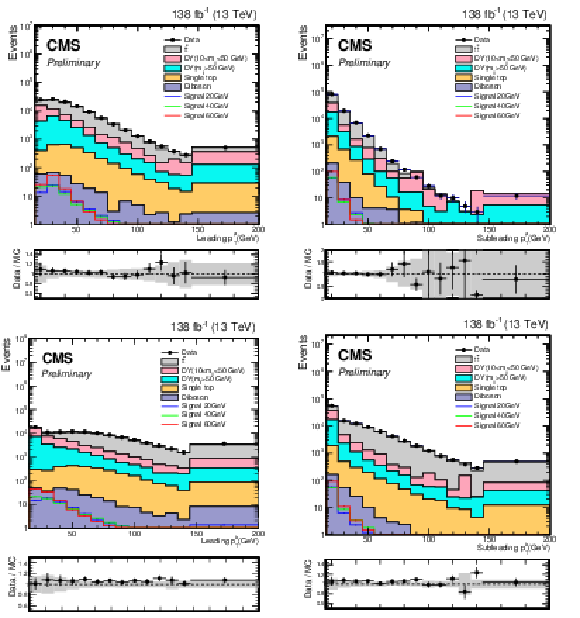
png pdf |
Figure 1:
The distribution of (top) leading and subleading muon $ p_{\mathrm{T}} $ and (bottom) leading and subleading jet $ p_{\mathrm{T}} $ in selected events. The uncertainty band in the lower panel represents the limited size of simulated samples together with a 30% uncertainty on the low mass Drell-Yan cross section. Simulated samples are normalized to 138 fb$^{-1}$ with the corresponding theoretical cross sections. The benchmark criteria explained in the text are used for signal normalization. |
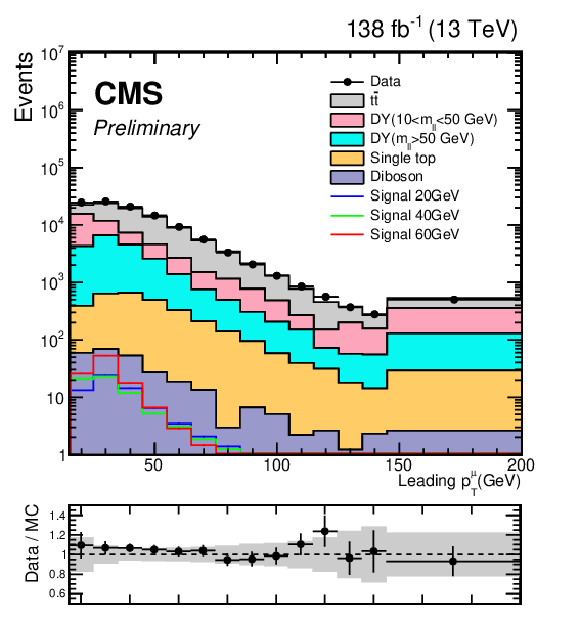
png pdf |
Figure 1-a:
The distribution of (top) leading and subleading muon $ p_{\mathrm{T}} $ and (bottom) leading and subleading jet $ p_{\mathrm{T}} $ in selected events. The uncertainty band in the lower panel represents the limited size of simulated samples together with a 30% uncertainty on the low mass Drell-Yan cross section. Simulated samples are normalized to 138 fb$^{-1}$ with the corresponding theoretical cross sections. The benchmark criteria explained in the text are used for signal normalization. |
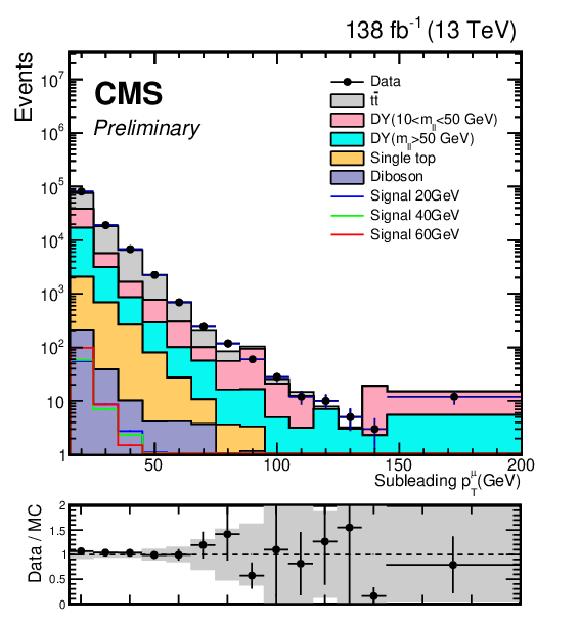
png pdf |
Figure 1-b:
The distribution of (top) leading and subleading muon $ p_{\mathrm{T}} $ and (bottom) leading and subleading jet $ p_{\mathrm{T}} $ in selected events. The uncertainty band in the lower panel represents the limited size of simulated samples together with a 30% uncertainty on the low mass Drell-Yan cross section. Simulated samples are normalized to 138 fb$^{-1}$ with the corresponding theoretical cross sections. The benchmark criteria explained in the text are used for signal normalization. |
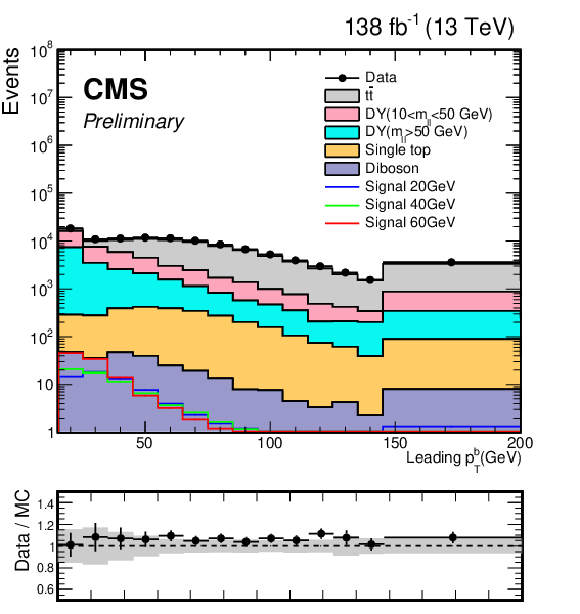
png pdf |
Figure 1-c:
The distribution of (top) leading and subleading muon $ p_{\mathrm{T}} $ and (bottom) leading and subleading jet $ p_{\mathrm{T}} $ in selected events. The uncertainty band in the lower panel represents the limited size of simulated samples together with a 30% uncertainty on the low mass Drell-Yan cross section. Simulated samples are normalized to 138 fb$^{-1}$ with the corresponding theoretical cross sections. The benchmark criteria explained in the text are used for signal normalization. |

png pdf |
Figure 1-d:
The distribution of (top) leading and subleading muon $ p_{\mathrm{T}} $ and (bottom) leading and subleading jet $ p_{\mathrm{T}} $ in selected events. The uncertainty band in the lower panel represents the limited size of simulated samples together with a 30% uncertainty on the low mass Drell-Yan cross section. Simulated samples are normalized to 138 fb$^{-1}$ with the corresponding theoretical cross sections. The benchmark criteria explained in the text are used for signal normalization. |
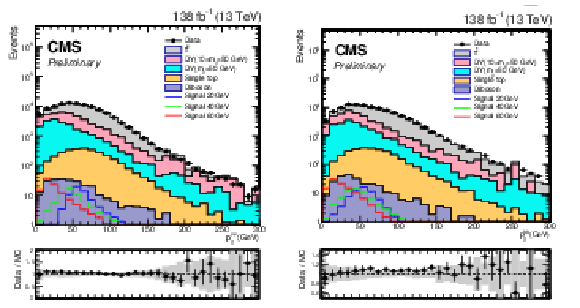
png pdf |
Figure 2:
The $ p_{\mathrm{T}} $ distributions of the (left) dimuon systems, (right) di-b-jets system. The uncertainty band in the lower panel represents the limited size of simulated samples together with a 30% uncertainty on the low mass Drell-Yan cross section. Simulated samples are normalized to 138 fb$^{-1}$ with the corresponding theoretical cross sections. The benchmark criteria explained in the text are used for signal normalization. |
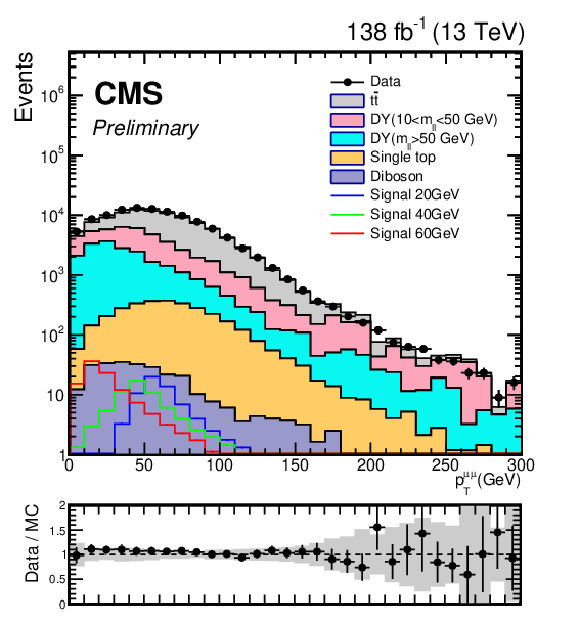
png pdf |
Figure 2-a:
The $ p_{\mathrm{T}} $ distributions of the (left) dimuon systems, (right) di-b-jets system. The uncertainty band in the lower panel represents the limited size of simulated samples together with a 30% uncertainty on the low mass Drell-Yan cross section. Simulated samples are normalized to 138 fb$^{-1}$ with the corresponding theoretical cross sections. The benchmark criteria explained in the text are used for signal normalization. |
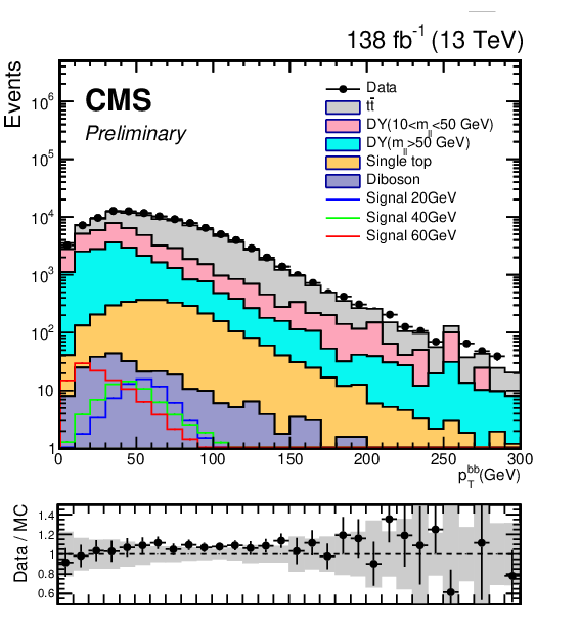
png pdf |
Figure 2-b:
The $ p_{\mathrm{T}} $ distributions of the (left) dimuon systems, (right) di-b-jets system. The uncertainty band in the lower panel represents the limited size of simulated samples together with a 30% uncertainty on the low mass Drell-Yan cross section. Simulated samples are normalized to 138 fb$^{-1}$ with the corresponding theoretical cross sections. The benchmark criteria explained in the text are used for signal normalization. |
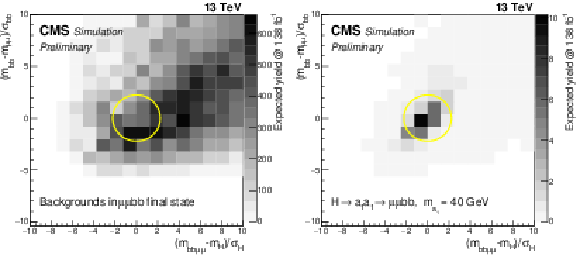
png pdf |
Figure 3:
The distribution of $ \chi_{\mathrm{b}\mathrm{b}} $ versus $ \chi_{\mathrm{H}} $ as defined in Eq. (4.11) for (left) simulated background processes, and (right) the signal process with $ m_{\rm a_1} = $ 40 GeV. The contours encircle the area with $ \chi_{\rm tot} $ below an arbitrary value. The grey scale represents the expected yields at 138 fb$^{-1}$. |

png pdf |
Figure 3-a:
The distribution of $ \chi_{\mathrm{b}\mathrm{b}} $ versus $ \chi_{\mathrm{H}} $ as defined in Eq. (4.11) for (left) simulated background processes, and (right) the signal process with $ m_{\rm a_1} = $ 40 GeV. The contours encircle the area with $ \chi_{\rm tot} $ below an arbitrary value. The grey scale represents the expected yields at 138 fb$^{-1}$. |

png pdf |
Figure 3-b:
The distribution of $ \chi_{\mathrm{b}\mathrm{b}} $ versus $ \chi_{\mathrm{H}} $ as defined in Eq. (4.11) for (left) simulated background processes, and (right) the signal process with $ m_{\rm a_1} = $ 40 GeV. The contours encircle the area with $ \chi_{\rm tot} $ below an arbitrary value. The grey scale represents the expected yields at 138 fb$^{-1}$. |

png pdf |
Figure 4:
Signal ($ m_{\rm a_1}= $ 40 GeV) versus background efficiency for different thresholds on $ \chi_{\rm tot}^2 $ (gray) and $ \chi_{\rm d}^2 $ (red) variables. The black star indicates signal efficiency versus that of background for the optimized $ \chi_{\rm d}^2 $ requirement. |
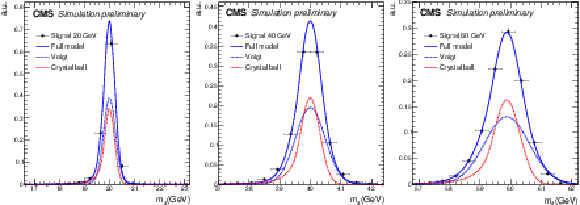
png pdf |
Figure 5:
The modeling of $ m_{\mu\mu} $ distribution in simulated signal events with (left) $ m_{\rm a_1} = $ 20 GeV, (middle) $ m_{\rm a_1} = $ 40 GeV, and (right) $ m_{\rm a_1} = $ 60 GeV. The full model (solid blue) is a weighted sum of the Voigt profile (dashed blue) and the Crystal ball function (dashed red). |
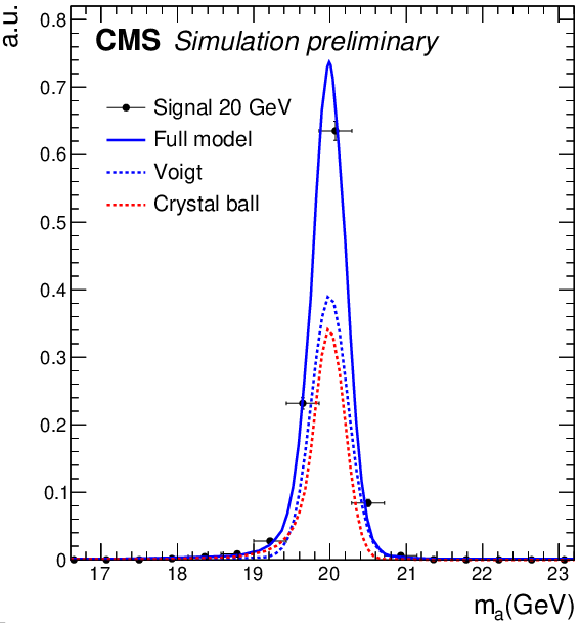
png pdf |
Figure 5-a:
The modeling of $ m_{\mu\mu} $ distribution in simulated signal events with (left) $ m_{\rm a_1} = $ 20 GeV, (middle) $ m_{\rm a_1} = $ 40 GeV, and (right) $ m_{\rm a_1} = $ 60 GeV. The full model (solid blue) is a weighted sum of the Voigt profile (dashed blue) and the Crystal ball function (dashed red). |

png pdf |
Figure 5-b:
The modeling of $ m_{\mu\mu} $ distribution in simulated signal events with (left) $ m_{\rm a_1} = $ 20 GeV, (middle) $ m_{\rm a_1} = $ 40 GeV, and (right) $ m_{\rm a_1} = $ 60 GeV. The full model (solid blue) is a weighted sum of the Voigt profile (dashed blue) and the Crystal ball function (dashed red). |
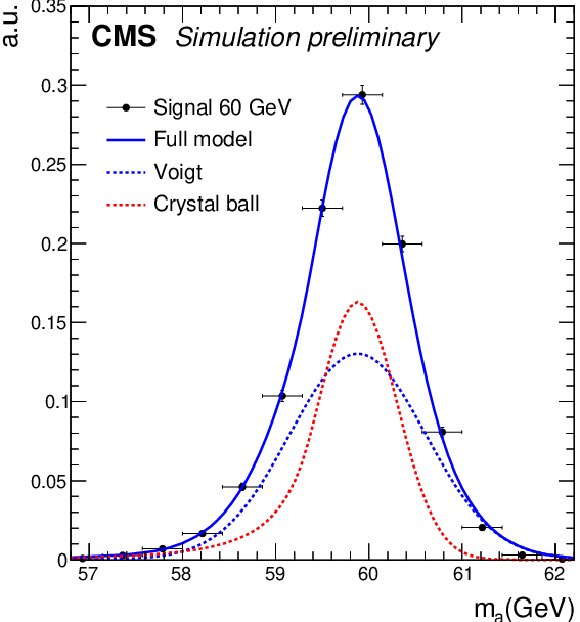
png pdf |
Figure 5-c:
The modeling of $ m_{\mu\mu} $ distribution in simulated signal events with (left) $ m_{\rm a_1} = $ 20 GeV, (middle) $ m_{\rm a_1} = $ 40 GeV, and (right) $ m_{\rm a_1} = $ 60 GeV. The full model (solid blue) is a weighted sum of the Voigt profile (dashed blue) and the Crystal ball function (dashed red). |
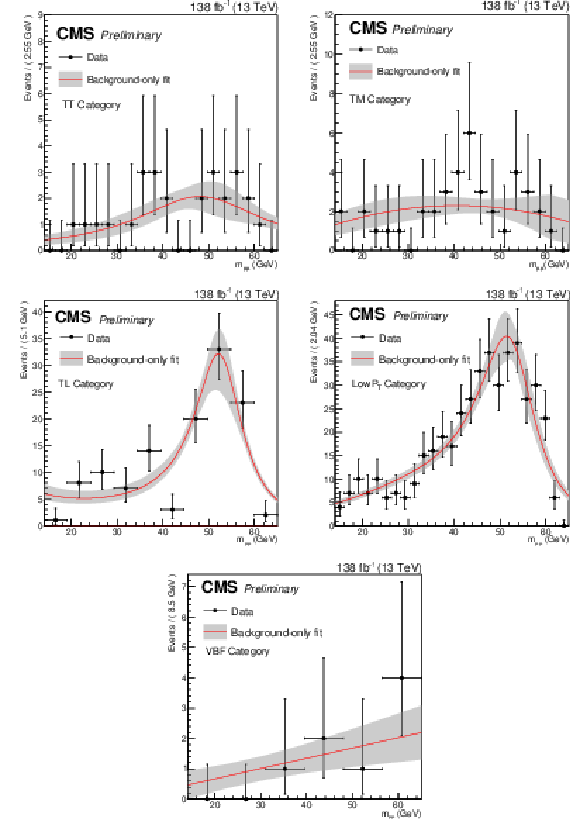
png pdf |
Figure 6:
The best-fit background models together with 68% CL uncertainty band from the fit to the data under the background-only hypothesis for the (top left) TT category, (top right) TM, (middle left) TL category, (middle right) Low$ p_{\mathrm{T}} $ category, and (bottom) VBF category. |
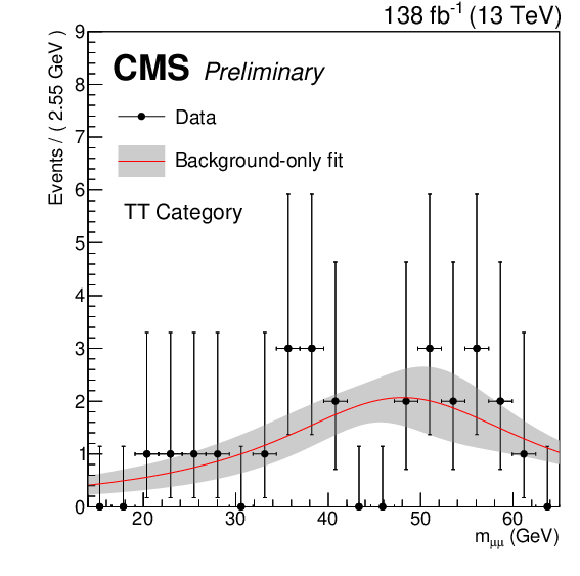
png pdf |
Figure 6-a:
The best-fit background models together with 68% CL uncertainty band from the fit to the data under the background-only hypothesis for the (top left) TT category, (top right) TM, (middle left) TL category, (middle right) Low$ p_{\mathrm{T}} $ category, and (bottom) VBF category. |

png pdf |
Figure 6-b:
The best-fit background models together with 68% CL uncertainty band from the fit to the data under the background-only hypothesis for the (top left) TT category, (top right) TM, (middle left) TL category, (middle right) Low$ p_{\mathrm{T}} $ category, and (bottom) VBF category. |

png pdf |
Figure 6-c:
The best-fit background models together with 68% CL uncertainty band from the fit to the data under the background-only hypothesis for the (top left) TT category, (top right) TM, (middle left) TL category, (middle right) Low$ p_{\mathrm{T}} $ category, and (bottom) VBF category. |
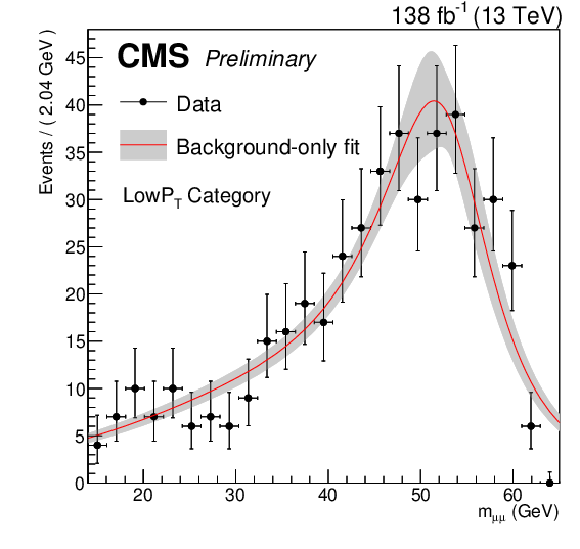
png pdf |
Figure 6-d:
The best-fit background models together with 68% CL uncertainty band from the fit to the data under the background-only hypothesis for the (top left) TT category, (top right) TM, (middle left) TL category, (middle right) Low$ p_{\mathrm{T}} $ category, and (bottom) VBF category. |

png pdf |
Figure 6-e:
The best-fit background models together with 68% CL uncertainty band from the fit to the data under the background-only hypothesis for the (top left) TT category, (top right) TM, (middle left) TL category, (middle right) Low$ p_{\mathrm{T}} $ category, and (bottom) VBF category. |
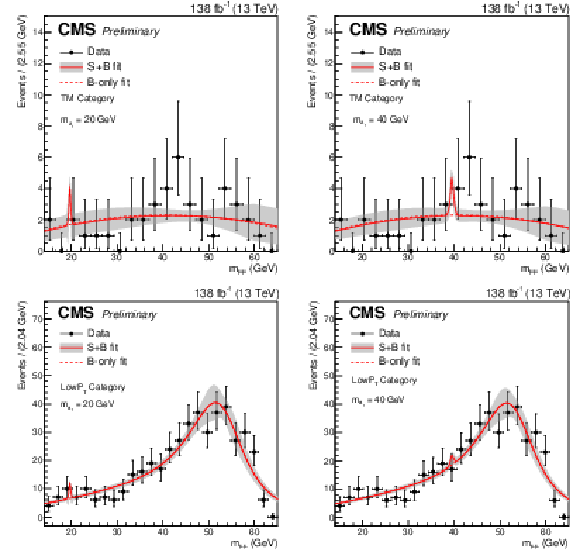
png pdf |
Figure 7:
The signal-plus-background fit for two signal hypotheses, (left) $ m_{a_{1}} \!= $ 20 GeV and (right) $ m_{a_{1}} \!= $ 40 GeV, in two given categories, (top) TM and (bottom) LowPt. |
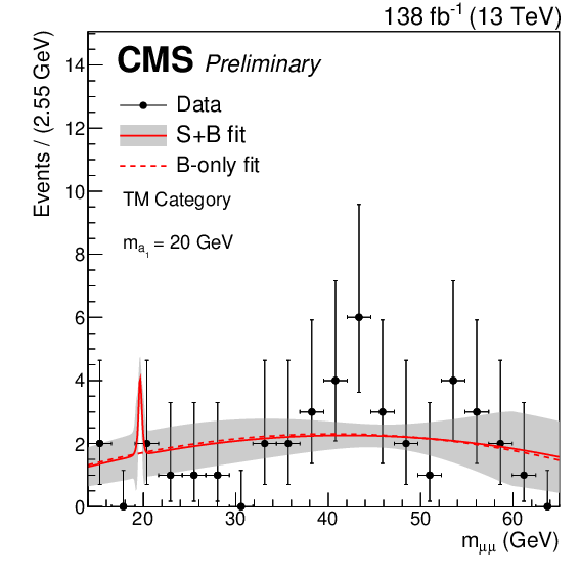
png pdf |
Figure 7-a:
The signal-plus-background fit for two signal hypotheses, (left) $ m_{a_{1}} \!= $ 20 GeV and (right) $ m_{a_{1}} \!= $ 40 GeV, in two given categories, (top) TM and (bottom) LowPt. |

png pdf |
Figure 7-b:
The signal-plus-background fit for two signal hypotheses, (left) $ m_{a_{1}} \!= $ 20 GeV and (right) $ m_{a_{1}} \!= $ 40 GeV, in two given categories, (top) TM and (bottom) LowPt. |
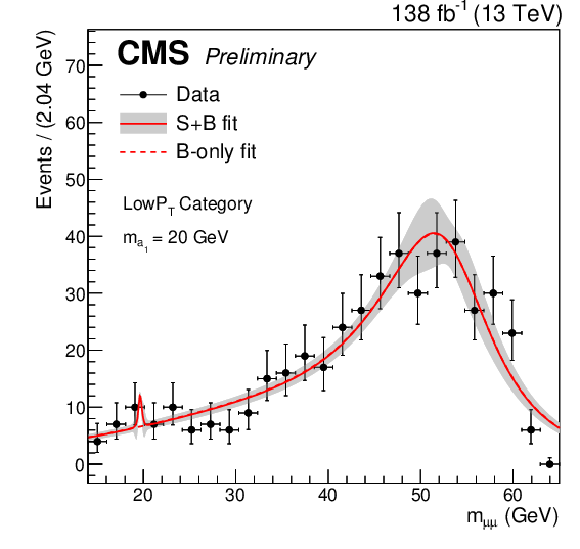
png pdf |
Figure 7-c:
The signal-plus-background fit for two signal hypotheses, (left) $ m_{a_{1}} \!= $ 20 GeV and (right) $ m_{a_{1}} \!= $ 40 GeV, in two given categories, (top) TM and (bottom) LowPt. |
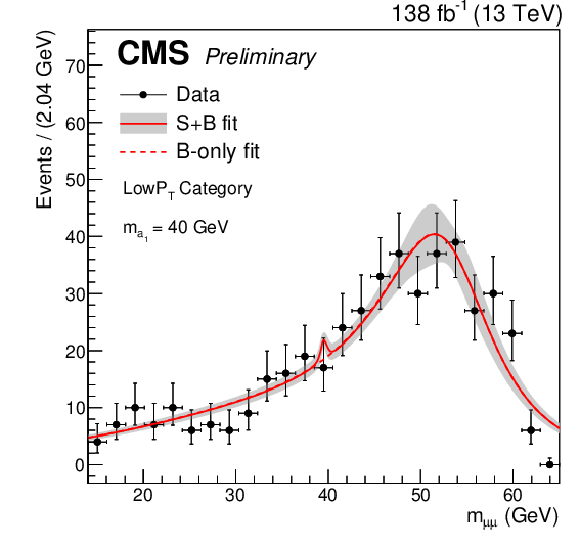
png pdf |
Figure 7-d:
The signal-plus-background fit for two signal hypotheses, (left) $ m_{a_{1}} \!= $ 20 GeV and (right) $ m_{a_{1}} \!= $ 40 GeV, in two given categories, (top) TM and (bottom) LowPt. |

png pdf |
Figure 8:
Observed and expected upper limits at 95% CL on $ {\rm Br}({\mathrm{H}}\to{\rm a_1 a_1}\to\mu^{+}\mu^{-}{\mathrm{b}}{\overline{\mathrm{b}}}) $ as a function of $ m_{\rm a_1} $. The inner and outer bands indicate the regions containing the distribution of limits located within 68 and 95% confidence intervals, respectively, of the expectation under the background-only hypothesis. |
| Tables | |

png pdf |
Table 1:
Event yields for simulated processes and the number of observed events in data after applying $ \chi_{\rm d}^2 < $ 1.5. The expected number of simulated events is normalized to the integrated luminosity of 138 fb$^{-1}$. The type-III parametrization of 2HDM+S with $ \tan\beta= $ 2 is used to evaluate Br($ {\rm a_1}\to ff $). |
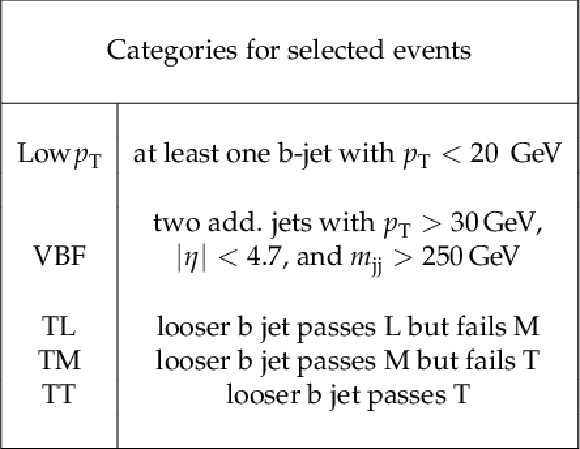
png pdf |
Table 2:
Summary of categorization requirements. Events in these categories contain two muons and two b-jets as described in Section 4. As stated in the text, L, M, and T respectively stand for the loose, medium, and tight b-tag criteria. |

png pdf |
Table 3:
The expected yields for backgrounds and different signal hypotheses in each category. Since the individual numbers are rounded, the total yields are slightly different from the sum of the individual entries. The benchmark criteria explained in the text are used to estimate the signal yields. |
| Summary |
| A search for exotic decays of a Higgs boson with $ m_{\mathrm{H}}= $ 125 GeV is performed in the $ \mu\mu\mathrm{b}\mathrm{b} $ final state with the CMS detector using LHC proton-proton collision data at 13 TeV center-of-mass energy. The decay is assumed to proceed through a pair of new pseudoscalars, $ {\rm a_1}\to ff $, that interact with standard model (SM) fermions ($ f $) via mixing with the Higgs boson. The mass of the pseudoscalar is considered to be 15 $ \leq m_{\rm a_1}\leq $ 62.5 GeV. The data sample corresponds to an integrated luminosity of 138 fb$^{-1}$. The expected topology of the signal, i.e.,, the mass requirements on the combination of the decay products, is exploited to enhance the sensitivity. The detector resolution effects, especially on b jets are taken into account. Introducing a new basis for the kinematical properties of the muons and b jets to decorrelate the di-b-jet and $ \mu\mu\mathrm{b}\mathrm{b} $ systems results in a major improvement with respect to the earlier CMS study based on partial data sample at 13 TeV [25]. For the signal hypotheses with low mass, the limits are improved by the addition of a dedicated category for events with low-$ p_{\mathrm{T}} $ jets. In the absence of any significant excess over the SM backgrounds, upper limits are set on $ {\rm Br}({\mathrm{H}}\to{\rm a_1 a_1}\to\mu^{+}\mu^{-}{\mathrm{b}}{\overline{\mathrm{b}}}) $ at 95% confidence level. These limits are in the range $ (0.17-3.3)\times 10^{{\rm -4}} $, depending on the $ m_{\rm a_1} $ hypothesis. |
| References | ||||
| 1 | ATLAS Collaboration | Observation of a new particle in the search for the Standard Model Higgs boson with the ATLAS detector at the LHC | Phys. Lett. B 716, 2012 link |
1207.7214 |
| 2 | CMS Collaboration | Observation of a new boson at a mass of 125 GeV with the CMS experiment at the LHC | Phys. Lett. B 716, 2012 link |
CMS-HIG-12-028 1207.7235 |
| 3 | L. Evans and P. Bryant | LHC Machine | JINST 3 S08001, 2008 link |
|
| 4 | ATLAS Collaboration | Measurement of the Higgs boson mass in the $ H \rightarrow ZZ^* \rightarrow 4\ell $ decay channel using 139 fb$ ^{-1} $ of $ \sqrt{s}= $ 13 TeV $ pp $ collisions recorded by the ATLAS detector at the LHC | Submitted to PLB, 2022 | 2207.00320 |
| 5 | CMS Collaboration | A measurement of the Higgs boson mass in the diphoton decay channel | Phys. Lett. B 805, 2020 link |
CMS-HIG-19-004 2002.06398 |
| 6 | CMS Collaboration | Observation of $ {{\mathrm{t}\overline{\mathrm{t}}} \mathrm{H}} $ production | Phys. Rev. Lett. 120 (Jun,), 2018 link |
CMS-HIG-17-035 1804.02610 |
| 7 | ATLAS Collaboration | Observation of Higgs boson production in association with a top quark pair at the LHC with the ATLAS detector | Phys. Lett. B 784, 2018 link |
1806.00425 |
| 8 | ATLAS Collaboration | Observation of $ \mathrm{H} \rightarrow \mathrm{b}\overline{\mathrm{b}} $ decays and $ V\mathrm{H} $ production with the ATLAS detector | Phys. Lett. B 786, 2018 link |
1808.08238 |
| 9 | CMS Collaboration | Observation of Higgs boson decay to bottom quarks | Phys. Rev. Lett. 121, 2018 link |
CMS-HIG-18-016 1808.08242 |
| 10 | ATLAS Collaboration | A search for the dimuon decay of the Standard Model Higgs boson with the ATLAS detector | Phys. Lett. B 812, 2021 link |
2007.07830 |
| 11 | CMS Collaboration | Evidence for Higgs boson decay to a pair of muons | JHEP 01, 2021 link |
CMS-HIG-19-006 2009.04363 |
| 12 | ATLAS Collaboration | Combined measurements of Higgs boson production and decay using up to 80 $ \text{ }\text{ }{\mathrm{fb}}^{-1} $ of proton-proton collision data at $ \sqrt{s}=13\text{ }\text{ }\mathrm{TeV} $ collected with the ATLAS experiment | Phys. Rev. D 101, 2020 link |
1909.02845 |
| 13 | CMS Collaboration | Combined measurements of Higgs boson couplings in proton-proton collisions at $ \sqrt{s}=13\,\text {Te}\text {V} $ | Eur. Phys. J. C 79, no 5, 2019 link |
CMS-HIG-17-031 1809.10733 |
| 14 | CMS Collaboration | A portrait of the Higgs boson by the CMS experiment ten years after the discovery | Nature 607, no 7917, 2022 link |
CMS-HIG-22-001 2207.00043 |
| 15 | G. Belanger et al. | Status of invisible Higgs decays | Phys. Lett. B 723, 2013 link |
1302.5694 |
| 16 | P. P. Giardino et al. | The universal Higgs fit | JHEP 05 (2014) 046 link |
1303.3570 |
| 17 | J. Ellis and T. You | Updated Global Analysis of Higgs Couplings | JHEP 06 (2013) 103 link |
1303.3879 |
| 18 | K. Cheung, J. S. Lee, and P.-Y. Tseng | Higgs Precision (Higgcision) Era begins | JHEP 05 (2013) 134 link |
1302.3794 |
| 19 | M. Cepeda et al. | Report from Working Group 2: Higgs Physics at the HL-LHC and HE-LHC | CERN Yellow Rep. Monogr. 7, 2019 link |
1902.00134 |
| 20 | D. Curtin et al. | Exotic decays of the 125 GeV Higgs boson | Phys. Rev. D 90, 2014 link |
1312.4992 |
| 21 | CMS Collaboration | Search for light bosons in decays of the 125 GeV Higgs boson in proton-proton collisions at $ \sqrt{s} $ = 8 TeV | JHEP 17, no 10, 2017 link |
CMS-HIG-16-015 1701.02032 |
| 22 | LHC Higgs cross section working group Collaboration | Handbook of LHC Higgs cross sections: 4. Deciphering the nature of the Higgs sector | cern report, 10, 2016 link |
1610.07922 |
| 23 | ATLAS Collaboration | Search for Higgs boson decays into a pair of pseudoscalar particles in the $ bb\mu\mu $ final state with the ATLAS detector in $ pp $ collisions at $ \sqrt{s}= $ 13 TeV | Phys. Rev. D 105, no 1, 2022 link |
2110.00313 |
| 24 | ATLAS Collaboration | Search for Higgs boson decays into a pair of light bosons in the $ \mathrm{b}\mathrm{b}\mu\mu $ final state in pp collision at $ \sqrt{s} = $ 13 TeV with the ATLAS detector | PLB 790 (2019) 1 | 1807.00539 |
| 25 | CMS Collaboration | Search for an exotic decay of the Higgs boson to a pair of light pseudoscalars in the final state with two muons and two b quarks in pp collisions at 13 tev | Phys. Lett. B 795, 2019 link |
CMS-HIG-18-011 1812.06359 |
| 26 | CMS Collaboration | Performance of the CMS Level-1 trigger in proton-proton collisions at $ \sqrt{s} = $ 13\,TeV | JINST 15 (2020) P10017 | CMS-TRG-17-001 2006.10165 |
| 27 | CMS Collaboration | The CMS trigger system | JINST 12 (2017) P01020 | CMS-TRG-12-001 1609.02366 |
| 28 | CMS Collaboration | The CMS experiment at the CERN LHC | JINST 3 (2008) S08004 | |
| 29 | J. Alwall et al. | The automated computation of tree-level and next-to-leading order differential cross sections, and their matching to parton shower simulations | JHEP 07, 2014 link |
1405.0301 |
| 30 | A. Johan et al. | Comparative study of various algorithms for the merging of parton showers and matrix elements in hadronic collisions | EPJC 53 (2008) 473 | 0706.2569 |
| 31 | R. Frederix and S. Frixione | Merging meets matching in MC@NLO | JHEP 12 (2012) 061 | 1209.6215 |
| 32 | E. Re | Single-top Wt-channel production matched with parton showers using the POWHEG method | Eur. Phys. J. 71 (2011) 1547 | 1009.2450 |
| 33 | S. Alioli, P. Nason, C. Oleari, and E. Re | A general framework for implementing NLO calculations in shower Monte Carlo programs: the POWHEG BOX | JHEP 06 (2010) 043 | 1002.2581 |
| 34 | S. Alioli, P. Nason, C. Oleari, and E. Re | NLO single-top production matched with shower in POWHEG: s- and t-channel contributions | [Erratum: JHEP02,011)], 2009 JHEP 09 (2009) 111 |
0907.4076 |
| 35 | S. Frixione, P. Nason, and C. Oleari | Matching NLO QCD computations with parton shower simulations: the POWHEG method | JHEP 11 (2007) 070 | 0709.2092 |
| 36 | N. Paolo | A new method for combining NLO QCD with shower MonteCarlo algorithms | JHEP 11 (2004) 040 | hep-ph/0409146 |
| 37 | T. Sjöstrand, S. Mrenna, and P. Skands | A brief introduction to PYTHIA 8.1 | Comput. Phys. Commun. 178 (2008) 852 | 0710.3820 |
| 38 | P. Skands, S. Carrazza, and J. Rojo | Tuning PYTHIA 8.1: the Monash 2013 tune | Eur. Phys. J. 74, no 8, 3024, 2014 link |
1404.5630 |
| 39 | CMS Collaboration | Extraction and validation of a new set of CMS PYTHIA8 tunes from underlying-event measurements | Eur. Phys. J. C 80 (jan,), 2020 link |
CMS-GEN-17-001 1903.12179 |
| 40 | NNPDF Collaboration | Unbiased global determination of parton distributions and their uncertainties at NNLO and at LO | Nucl. Phys. B 855, 2012 link |
1107.2652 |
| 41 | NNPDF Collaboration | Parton distributions from high-precision collider data | Eur. Phys. J. C 77, no 10, 2017 link |
1706.00428 |
| 42 | GEANT4 Collaboration | GEANT4: A simulation toolkit | NIM A 506 (2003) 250 | |
| 43 | CMS Collaboration | Particle-flow reconstruction and global event description with the CMS detector | JINST, 2017 link |
CMS-PRF-14-001 1706.04965 |
| 44 | CMS Collaboration | Technical proposal for the Phase-II upgrade of the Compact Muon Solenoid | CMS Technical Proposal CERN-LHCC-2015-010, CMS-TDR-15-02, 2015 CDS |
|
| 45 | CMS Collaboration | Performance of the CMS muon detector and muon reconstruction with proton-proton collisions at $ \sqrt{s}= $ 13 TeV | JINST 13 (2018) P06015 | CMS-MUO-16-001 1804.04528 |
| 46 | M. Cacciari, G. P. Salam, and G. Soyez | The anti-$ k_{\mathrm{T}} $ jet clustering algorithm | JHEP 04 (2008) 063 | 0802.1189 |
| 47 | M. Cacciari, G. P. Salam, and G. Soyez | FastJet user manual | EPJC 72 (2012) 1896 | 1111.6097 |
| 48 | CMS Collaboration | Jet algorithms performance in 13 TeV data | Physics Analysis Summary , CERN, Geneva, 2017 CMS-PAS-JME-16-003 |
CMS-PAS-JME-16-003 |
| 49 | CMS Collaboration | Determination of jet energy calibration and transverse momentum resolution in CMS | JINST 6 (2011) 11002 | CMS-JME-10-011 1107.4277 |
| 50 | E. Bols et al. | Jet flavour classification using DeepJet | JINST 15, no 12, P, 2020 link |
2008.10519 |
| 51 | CMS Collaboration | Identification of heavy-flavour jets with the CMS detector in pp collisions at 13 TeV | JINST 13 (2018) P05011 | CMS-BTV-16-002 1712.07158 |
| 52 | CMS Collaboration | Performance of the DeepJet b tagging algorithm using 41.9/fb of data from proton-proton collisions at 13 TeV with Phase 1 CMS detector | CMS Detector Performance Note CMS-DP-2018-058, 2018 CDS |
|
| 53 | G. Pagnini and R. K. Saxena | A note on the Voigt profile function | 0805.2274 | |
| 54 | M. J. Oreglia | A study of the reactions $ \psi^\prime \to \gamma \gamma \psi $ | \href http://www.slac.stanford.edu/cgi-wrap/getdoc/slac-r-236.pdf. PhD thesis, Stanford University,. SLAC Report SLAC-R-236, 1980 | |
| 55 | F. James | Statistical methods in experimental physics | World Scientific, Singapore, 2nd edition,. ISBN~9789812567956, 2007 | |
| 56 | P. D. Dauncey, M. Kenzie, N. Wardle, and G. J. Davies | Handling uncertainties in background shapes: the discrete profiling method | JINST 10, no 04, P04015, 2015 link |
1408.6865 |
| 57 | CMS Collaboration | Observation of the diphoton decay of the Higgs boson and measurement of its properties | Eur. Phys. J. 74, no 10, 3076, 2014 link |
CMS-HIG-13-001 1407.0558 |
| 58 | ATLAS and C. Collaborations | Combined measurement of the Higgs boson mass in $ pp $ collisions at $ \sqrt{s}= $ 7 and 8 TeV with the ATLAS and CMS experiments | PRL 114 (2015) 191803 | 1503.07589 |
| 59 | CMS Collaboration | Precision luminosity measurement in proton-proton collisions at $ \sqrt{s} = $ 13 TeV in 2015 and 2016 at CMS | Eur. Phys. J. C 81, no 9, 2021 link |
CMS-LUM-17-003 2104.01927 |
| 60 | CMS Collaboration | CMS luminosity measurement for the 2017 data-taking period at $ \sqrt{s}= $ 13 TeV | CMS Physics Analysis Summary, 2018 CMS-PAS-LUM-17-004 |
CMS-PAS-LUM-17-004 |
| 61 | CMS Collaboration | CMS luminosity measurement for the 2018 data-taking period at $ \sqrt{s}= $ 13 TeV | CMS Physics Analysis Summary, 2019 CMS-PAS-LUM-18-002 |
CMS-PAS-LUM-18-002 |
| 62 | CMS Collaboration | Measurement of the inelastic proton-proton cross section at $ \sqrt{s}= $ 13 TeV | JHEP 07 (2018) 161 | CMS-FSQ-15-005 1802.02613 |
| 63 | CMS Collaboration | Measurements of inclusive w and z cross sections in pp collisions at $ \sqrt {s} = $ 7 tev | JHEP 01, 2011 link |
CMS-EWK-10-002 1012.2466 |
| 64 | T. Junk | Confidence level computation for combining searches with small statistics | NIM A 434 (1999) 435 | hep-ex/9902006 |
| 65 | A. L. Read | Presentation of search results: The CL$ _{\text{s}} $ technique | JPG 28 (2002) 2693 | |
| 66 | G. Cowan, K. Cranmer, E. Gross, and O. Vitells | Asymptotic formulae for likelihood-based tests of new physics | EPJC 71 (2011) 1554 | 1007.1727 |

|
Compact Muon Solenoid LHC, CERN |

|

|

|

|

|

|